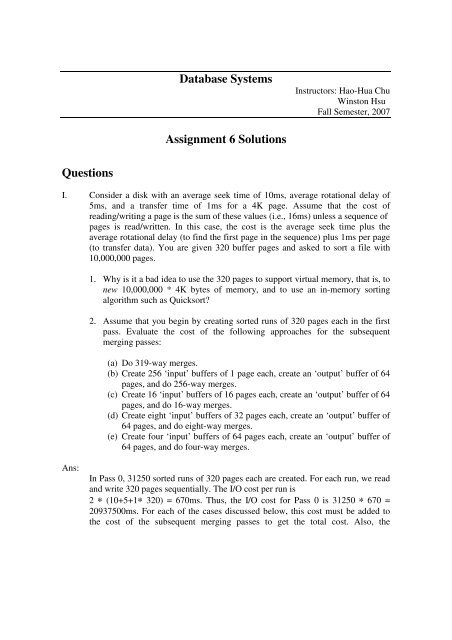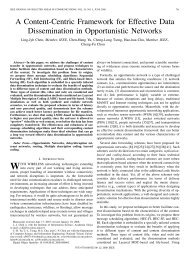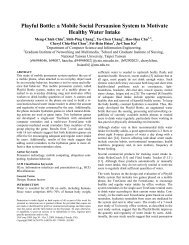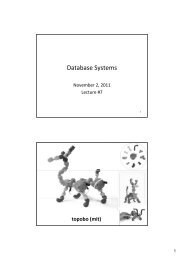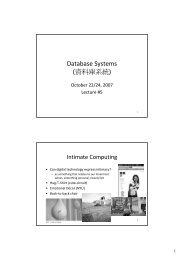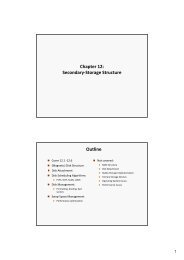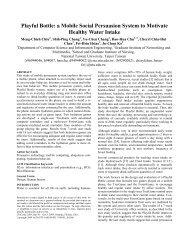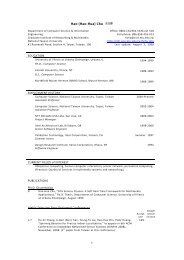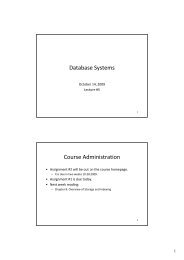Database Systems Assignment 6 Solutions Questions
Database Systems Assignment 6 Solutions Questions
Database Systems Assignment 6 Solutions Questions
You also want an ePaper? Increase the reach of your titles
YUMPU automatically turns print PDFs into web optimized ePapers that Google loves.
<strong>Questions</strong><br />
<strong>Database</strong> <strong>Systems</strong><br />
<strong>Assignment</strong> 6 <strong>Solutions</strong><br />
Instructors: Hao-Hua Chu<br />
Winston Hsu<br />
Fall Semester, 2007<br />
I. Consider a disk with an average seek time of 10ms, average rotational delay of<br />
5ms, and a transfer time of 1ms for a 4K page. Assume that the cost of<br />
reading/writing a page is the sum of these values (i.e., 16ms) unless a sequence of<br />
pages is read/written. In this case, the cost is the average seek time plus the<br />
average rotational delay (to find the first page in the sequence) plus 1ms per page<br />
(to transfer data). You are given 320 buffer pages and asked to sort a file with<br />
10,000,000 pages.<br />
Ans:<br />
1. Why is it a bad idea to use the 320 pages to support virtual memory, that is, to<br />
new 10,000,000 * 4K bytes of memory, and to use an in-memory sorting<br />
algorithm such as Quicksort?<br />
2. Assume that you begin by creating sorted runs of 320 pages each in the first<br />
pass. Evaluate the cost of the following approaches for the subsequent<br />
merging passes:<br />
(a) Do 319-way merges.<br />
(b) Create 256 ‘input’ buffers of 1 page each, create an ‘output’ buffer of 64<br />
pages, and do 256-way merges.<br />
(c) Create 16 ‘input’ buffers of 16 pages each, create an ‘output’ buffer of 64<br />
pages, and do 16-way merges.<br />
(d) Create eight ‘input’ buffers of 32 pages each, create an ‘output’ buffer of<br />
64 pages, and do eight-way merges.<br />
(e) Create four ‘input’ buffers of 64 pages each, create an ‘output’ buffer of<br />
64 pages, and do four-way merges.<br />
In Pass 0, 31250 sorted runs of 320 pages each are created. For each run, we read<br />
and write 320 pages sequentially. The I/O cost per run is<br />
2 ∗ (10+5+1∗ 320) = 670ms. Thus, the I/O cost for Pass 0 is 31250 ∗ 670 =<br />
20937500ms. For each of the cases discussed below, this cost must be added to<br />
the cost of the subsequent merging passes to get the total cost. Also, the
calculations below are slightly simplified by neglecting the effect of a final<br />
read/written block that is slightly smaller than the earlier blocks.<br />
1. For 319-way merges, only 2 more passes are needed. The first pass will<br />
produce ceiling(31250/319) = 98 sorted runs; these can then be merged in the<br />
next pass. Every page is read and written individually, at a cost of 16ms per<br />
read or write, in each of these two passes. The cost of these merging passes is<br />
therefore 2∗(2∗16)∗10000000 = 640000000ms.<br />
(The formula can be read as ‘number of passes times cost of read and write<br />
per page times number of pages in file’.)<br />
2. With 256-way merges, only two additional merging passes are needed. Every<br />
page in the file is read and written in each pass, but the effect of blocking is<br />
different on reads and writes. For reading, each page is read individually at a<br />
cost of 16ms. Thus, the cost of reads (over both passes) is<br />
2 ∗ 16 ∗ 10000000 = 320000000ms. For writing, pages are written out in<br />
blocks of 64 pages. The I/O cost per block is 10 + 5 + 1 ∗ 64 = 79ms. The<br />
number of blocks written out per pass is 10000000/64 = 156250, and the cost<br />
per pass is 156250∗79 = 12343750ms. The cost of writes over both merging<br />
passes is therefore 2 ∗ 12343750 = 24687500ms. The total cost of reads and<br />
writes for the two merging passes is 320000000 + 24687500 = 344687500ms.<br />
3. With 16-way merges, 4 additional merging passes are needed. For reading,<br />
pages are read in blocks of 16 pages, at a cost per block of 10 + 5 + 1 ∗ 16 =<br />
31ms. In each pass, 10000000/16 = 625000 blocks are read. The cost of<br />
reading over the 4 merging passes is therefore 4 ∗ 625000 ∗ 31 = 77500000ms.<br />
For writing, pages are written in 64 page blocks, and the cost per pass is<br />
12343750ms as before. The cost of writes over 4 merging passes is 4 ∗<br />
12343750 = 49375000ms, and the total cost of the merging passes is<br />
77500000+ 49375000 = 126875000ms.<br />
4. With 8-way merges, 5 merging passes are needed. For reading, pages are read<br />
in blocks of 32 pages, at a cost per block of 10 + 5 + 1 ∗ 32 = 47ms. In each<br />
pass, 10000000/32 = 312500 blocks are read. The cost of reading over the 5<br />
merging passes is therefore 5∗ 312500 ∗ 47 = 73437500ms. For writing, pages<br />
are written in 64 page blocks, and the cost per pass is 12343750ms as before.<br />
The cost of writes over 5 merging passes is 5 ∗ 12343750 = 61718750ms, and<br />
the total cost of the merging passes is 73437500+ 61718750 = 135156250ms.<br />
5. With 4-way merges, 8 merging passes are needed. For reading, pages are read<br />
in blocks of 64 pages, at a cost per block of 10 + 5 + 1 ∗ 64 = 79ms. In each<br />
pass, 10000000/64 = 156250 blocks are read. The cost of reading over the 8<br />
merging passes is therefore 8∗ 156250 ∗ 79 = 98750000ms. For writing, pages<br />
are written in 64 page blocks, and the cost per pass is 12343750ms as before.
The cost of writes over 8 merging passes is 8 ∗ 12343750 = 98750000ms, and<br />
the total cost of the merging passes is 98750000+ 98750000 = 197500000ms.<br />
II. Consider the join R∞R.a=S.bS, given the following information about the relations<br />
to be joined. The cost metric is the number of page I/Os unless otherwise noted,<br />
and the cost of writing out the result should be uniformly ignored.<br />
Relation R contains 10,000 tuples and has 10 tuples per page.<br />
Relation S contains 2000 tuples and also has 10 tuples per page.<br />
Attribute b of relation S is the primary key for S.<br />
Both relations are stored as simple heap files.<br />
Neither relation has any indexes built on it.<br />
52 buffer pages are available.<br />
1. What is the cost of joining R and S using a page-oriented simple nested loops<br />
join? What is the minimum number of buffer pages required for this cost to<br />
remain unchanged?<br />
2. What is the cost of joining R and S using a block nested loops join? What is<br />
the minimum number of buffer pages required for this cost to remain<br />
unchanged?<br />
3. What is the cost of joining R and S using a sort-merge join? What is the<br />
minimum number of buffer pages required for this cost to remain unchanged?<br />
4. What is the cost of joining R and S using a hash join? What is the minimum<br />
number of buffer pages required for this cost to remain unchanged?<br />
5. What would be the lowest possible I/O cost for joining R and S using any join<br />
algorithm, and how much buffer space would be needed to achieve this cost?<br />
Explain briefly.<br />
6. How many tuples does the join of R and S produce, at most, and how many<br />
pages are required to store the result of the join back on disk?<br />
7. Would your answers to any of the previous questions in this exercise change if<br />
you were told that R.a is a foreign key that refers to S.b?<br />
Ans: Let M =1000 be the number of pages in R, N = 200 be the number of pages in S,<br />
and B = 52 be the number of buffer pages available.<br />
1. Basic idea is to read each page of the outer relation, and for each page scan the<br />
inner relation for matching tuples. Total cost would be<br />
#pagesinouter + (#pagesinouter ∗ #pagesininner)<br />
which is minimized by having the smaller relation be the outer relation.<br />
TotalCost = N + (N ∗ M) = 200200<br />
The minimum number of buffer pages for this cost is 3.
2. This time read the outer relation in blocks, and for each block scan the inner<br />
relation for matching tuples. So the outer relation is still read once, but the<br />
inner relation is scanned only once for each outer block, of which there are<br />
ceiling ( #pages in outer / (B−2) ) = ceiling (200/50) = 4.<br />
TotalCost = N + M ∗ ceiling( N / (B−2) ) = 4200<br />
If the number of buffer pages is less than 52, the number of scans of the inner<br />
would be more than 4 since ceiling(200/49) = 5. The minimum number of<br />
buffer pages for this cost is therefore 52.<br />
3. Since B > √M > √N we can use the refinement to Sort-Merge :<br />
TotalCost = 3∗ (M + N) = 3600<br />
NOTE: if S.b were not a key, then the merging phase could require more than one pass<br />
over one of the relations, making the cost of merging M∗N I/Os in the worst case.<br />
The minimum number of buffer pages required is 25. With 25 buffer pages,<br />
the initial sorting pass will split R into 20 runs of size 50 and split S into 4<br />
runs of size 50 (approximately). These 24 runs can then be merged in one pass,<br />
with one page left over to be used as an output buffer. With fewer than 25<br />
buffer pages the number of runs produced by the first pass over both relations<br />
would exceed the number of available pages, making a one-pass merge<br />
impossible.<br />
4. The cost of Hash Join is 3∗(M+N) if B > √(f ∗ N) where f is a fudge factor<br />
used to capture the small increase in size involved in building a hash table,<br />
and N is the number of pages in the smaller relation, S (see page 258). Since<br />
√N ≈ 14, we can assume that this condition is met. We will also assume<br />
uniform partitioning from our hash function.<br />
TotalCost = 3∗ (M + N) = 3600<br />
Without knowing f we can only approximate the minimum number of buffer<br />
pages required, and a good guess is that we need B >√(f ∗ N).
5. The optimal cost would be achieved if each relation was only read once. We<br />
could do such a join by storing the entire smaller relation in memory, reading<br />
in the larger relation page-by-page, and for each tuple in the larger relation we<br />
search the smaller relation (which exists entirely in memory) for matching<br />
tuples. The buffer pool would have to hold the entire smaller relation, one<br />
page for reading in the larger relation, and one page to serve as an output<br />
buffer.<br />
TotalCost = M + N = 1, 200<br />
The minimum number of buffer pages for this cost is N + 1 + 1 = 202.<br />
6. Any tuple in R can match at most one tuple in S because S.b is a primary key<br />
(which means the S.b field contains no duplicates). So the maximum number<br />
of tuples in the result is equal to the number of tuples in R, which is 10,000.<br />
The size of a tuple in the result could be as large as the size of an R tuple plus<br />
the size of an S tuple (minus the size of the shared attribute). This may allow<br />
only 5 tuples to be stored on a page. Storing 10,000 tuples at 5 per page would<br />
require 2000 pages in the result.<br />
7. The foreign key constraint tells us that for every R tuple there is exactly one<br />
matching S tuple (because S.b is a key). The Sort-Merge and Hash Joins<br />
would not be affected, but we could reduce the cost of the two Nested Loops<br />
joins. If we make R the outer relation then for each tuple of R we only have to<br />
scan S until a match is found. This will require scanning only 50% of S on<br />
average.<br />
For Page-Oriented Nested Loops, the new cost would be<br />
and 3 buffer pages are still required.<br />
TotalCost = M + (M ∗ (N/2)) = 101 000<br />
For Block Nested Loops, the new cost would be<br />
TotalCost = M + (N/2) ∗ ceiling( M / (B−2) ) = 3000<br />
and again this cost can only be achieved with 52 available buffer pages.
III. Consider a database with objects X and Y and assume that there are two<br />
transactions T1 and T2. Transaction T 1 reads objects X and Y and then writes<br />
object X. Transaction T2 reads objects X and Y and then writes objects X and Y.<br />
Ans:<br />
1. Give an example schedule with actions of transactions T1 and T 2 on objects X<br />
and Y that results in a write-read conflict.<br />
2. Give an example schedule with actions of transactions T1 and T 2 on objects X<br />
and Y that results in a read-write conflict.<br />
3. Give an example schedule with actions of transactions T1 and T 2 on objects X<br />
and Y that results in a write-write conflict.<br />
4. For each of the three schedules, show that Strict 2PL disallows the schedule.<br />
1. The following schedule results in a write-read conflict:<br />
T2:R(X), T2:R(Y), T2:W(X), T1:R(X) ...<br />
T1:R(X) is a dirty read here.<br />
2. The following schedule results in a read-write conflict:<br />
T2:R(X), T2:R(Y), T1:R(X), T1:R(Y), T1:W(X) ...<br />
Now, T2 will get an unrepeatable read on X.<br />
3. The following schedule results in a write-write conflict:<br />
T2:R(X), T2:R(Y), T1:R(X), T1:R(Y), T1:W(X), T2:W(X) ...<br />
Now, T2 has overwritten uncommitted data.<br />
4. Strict 2PL resolves these conflicts as follows:<br />
(a) In S2PL, T1 could not get a shared lock on X because T2 would be<br />
Holding an exclusive lock on X. Thus, T1 would have to wait until T2<br />
was finished.<br />
(b) Here T1 could not get an exclusive lock on X because T2 would already<br />
be holding a shared or exclusive lock on X.<br />
(c) Same as above.<br />
IV. Consider the following classes of schedules: serializable, conflict-serializable,<br />
view-serializable, recoverable. For each of the following schedules, state which<br />
of the preceding classes it belongs to. If you cannot decide whether a schedule<br />
belongs in a certain class based on the listed actions, explain briefly.<br />
The actions are listed in the order they are scheduled and prefixed with the<br />
transaction name. If a commit or abort is not shown, the schedule is incomplete;<br />
assume that abort or commit must follow all the listed actions.
Ans:<br />
1. T1:R(X), T2:R(X), T1:W(X), T2:W(X)<br />
2. T1:W(X), T2:R(Y), T1:R(Y), T2:R(X)<br />
3. T1:R(X), T2:R(Y), T3:W(X), T2:R(X), T1:R(Y)<br />
4. T1:R(X), T1:R(Y), T1:W(X), T2:R(Y), T3:W(Y), T1:W(X), T2:R(Y)<br />
5. T1:R(X), T2:W(X), T1:W(X), T2:Abort, T1:Commit<br />
6. T1:R(X), T2:W(X), T1:W(X), T2:Commit, T1:Commit<br />
7. T1:W(X), T2:R(X), T1:W(X), T2:Abort, T1:Commit<br />
8. T1:W(X), T2:R(X), T1:W(X), T2:Commit, T1:Commit<br />
9. T1:W(X), T2:R(X), T1:W(X), T2:Commit, T1:Abort<br />
10. T2: R(X), T3:W(X), T3:Commit, T1:W(Y), T1:Commit, T2:R(Y), T2:W(Z),<br />
T2:Commit<br />
11. T1:R(X), T2:W(X), T2:Commit, T1:W(X), T1:Commit, T3:R(X), T3:Commit<br />
12. T1:R(X), T2:W(X), T1:W(X), T3:R(X), T1:Commit, T2:Commit, T3:Commit<br />
1. Not serializable, not conflict-serializable, not view-serializable; It is<br />
recoverable.<br />
2. It is serializable, conflict-serializable, and view-serializable;<br />
We can not decide whether it’s recoverable or not, since the abort/commit<br />
sequence of these two transactions are not specified.<br />
3. It is the same with number 2 above.<br />
4. It is NOT serializable, NOT conflict-serializable, NOT view-serializable;<br />
We can not decide whether it’s recoverable or not, since the abort/commit<br />
sequence of these transactions are not specified.<br />
5. It is serializable, conflict-serializable, and view-serializable;<br />
It is recoverabl.<br />
6. It is serializable and view-serializable, not conflict-serializable;<br />
It is recoverable<br />
7. It is not serializable, not view-serializable, not conflict-serializable;<br />
It is not recoverable.<br />
8. It is not serializable, not view-serializable, not conflict-serializable;<br />
It is not recoverable.<br />
9. It is serializable, view-serializable, and conflict-serializable;<br />
It is not recoverable.<br />
10. It belongs to all above classes.<br />
11. (assume the 2nd T2:Commit is instead T1:Commit).<br />
It is serializable and view-serializable, not conflict-serializable;<br />
It is recoverable.<br />
12. It is serializable and view-serializable, not conflict-serializable;<br />
It is recoverable.


